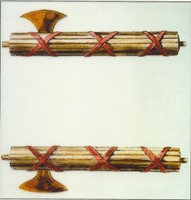"Kár pénzérme, rajta az etruszkoknál is megfigyelhető labrüsz"
 Tulajdonképpen a fasces is egy ilyen méltóságjelvény volt, csak ezen a bárd egyik élét már elhagyták (a szó ilyen értelemben plurale tantum, magyarra 'vesszőnyaláb'-ként szokás fordítani). Kezdetben az etruszk városállamok királyai előtt hordozta egy hivatalnok.
Tulajdonképpen a fasces is egy ilyen méltóságjelvény volt, csak ezen a bárd egyik élét már elhagyták (a szó ilyen értelemben plurale tantum, magyarra 'vesszőnyaláb'-ként szokás fordítani). Kezdetben az etruszk városállamok királyai előtt hordozta egy hivatalnok.
In the eighth century B.C.E., Etruria was made up of individualized city-states, each under the rule of a king. The kings acted as high priests during religious festivals as well as commanders-in-chiefs in battle. All Etruscan kings dressed in similar official garments. Each wore a flowing purple robe and carried a bronze scepter topped by a carved eagle. Each sat on an ivory throne that folded and was portable. During royal processions, the king was preceded by a official, who carried the emblem of royal power, the fasces: a bundle of sticks with the blade of an ax protruding from its center. The sticks in the fasces symbolized the king's power to destroy and rebuild his city-state if necessary; the ax symbolized his right to punish and execute wayward subjects. The fasces also signified that the king was the ultimate judge in any matters of civil justice within his territory.
A szöveg úgy magyarázza, hogy a fasces az uralkodó büntető hatalmát szimbolizálta, ezen belül rombolásra való képességét, valamint azt, hogy szükség esetén a várost újjá tudta építtetni.